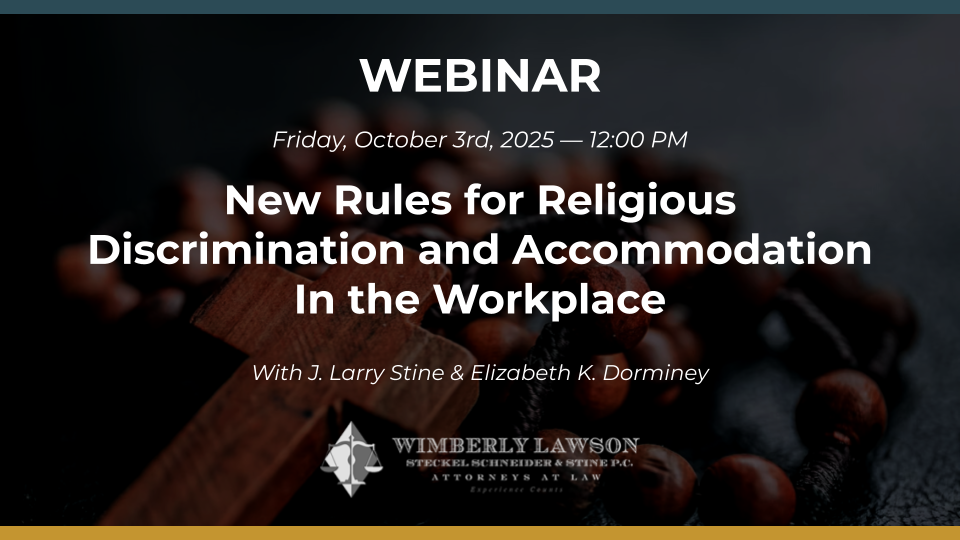NLRB Makes Big Changes to the Law, Surprising No One.
Anyone who knows anything about the National Labor Relations Board (NLRB) knows that its decisions tend to reflect the philosophy of the political party holding the White House. The current NLRB is proving to be no exception to that rule. Just this week, the NLRB issued two significant decisions that reverse precedents set during the Obama administration.
• Joint employer doctrine. In Hy-Brand Indus. Contractors, Ltd, 365 N.L.R.B. No. 156, (12/14/17), the NLRB expressly overruled its 2015 Browning-Ferris Industries decision on the issue of when multiple entities could be considered joint employers of a group of employees. Browning-Ferris was controversial because it reversed 30 years of NLRB precedent and made the standard to prove a joint employer relationship less stringent, holding that a joint employer relationship could be supported by evidence that a company merely had indirect or potential control over workers who were formally employed by another entity.
Hy-Brand takes us back to the previous standard, under which multiple entities could be considered joint employers of a group of employees only if each had exercised direct and immediate control over a group of employees. Companies with franchise relationships or leased employees will be especially happy to see a return to this stricter standard.
• Employee Handbooks. In The Boeing Company, 365 NLRB No. 154 ((12/14/17), the NLRB overruled the Lutheran Heritage precedent in a decision in a case involving the Boeing's maintenance of a “no-camera” rule which banned workers from using devices to take photos or videos on job sites without permission. In the Lutheran Heritage case, the NLRB had barred neutrally worded employer handbook rules if they would be “reasonably construed” by an employee to prohibit the exercise of National Labor Relations Act rights.
In the just-released Boeing decision, the NLRB said that it will instead shift to a different test for analyzing workplace policies under federal labor law:
When evaluating a facially neutral policy, rule or handbook provision that, when reasonably interpreted, would potentially interfere with the exercise of NLRA rights, the Board will evaluate two things: (i) the nature and extent of the potential impact on NLRA rights, and (ii) legitimate justifications associated with the rule. The Board will conduct this evaluation, consistent with the Board’s “duty to strike the proper balance between . . . asserted business justifications and the invasion of employee rights in light of the Act and its policy,” focusing on the perspective of employees, which is consistent with Section 8(a)(1). As the result of this balancing, the Board will delineate three categories of employment policies, rules and handbook provisions (hereinafter referred to as “rules”):
• Category 1 will include rules that the Board designates as lawful to maintain, either because (i) the rule, when reasonably interpreted, does not prohibit or interfere with the exercise of NLRA rights; or (ii) the potential adverse impact on protected rights is outweighed by justifications associated with the rule. Examples of Category 1 rules are the no-camera requirement in the Boeing case, the “harmonious interactions and relationships” rule that was at issue in William Beaumont Hospital, and other rules requiring employees to abide by basic standards of civility.
• Category 2 will include rules that warrant individualized scrutiny in each case as to whether the rule would prohibit or interfere with NLRA rights, and if so, whether any adverse impact on NLRA-protected conduct is outweighed by legitimate justifications.
• Category 3 will include rules that the Board will designate as unlawful to maintain because they would prohibit or limit NLRA-protected conduct, and the adverse impact on NLRA rights is not outweighed by justifications associated with the rule. An example of a Category 3 rule would be a rule that prohibits employees from discussing wages or benefits with one another.
The Board went on to note that the above three categories will represent a classification of results from the Board’s application of the new test, and that the categories are not part of the test itself. The Board will determine, in future cases, what types of additional rules fall into which category. The Board believes this new test will bring greater clarity to this area, but that remains to be seen. This Board is certainly giving employers more leew

Kathleen J. Jennings is a former principal in the Atlanta office of Wimberly, Lawson, Steckel, Schneider, & Stine, P.C. She defends employers in employment matters, such as sexual harassment, discrimination, Wage and Hour, OSHA, restrictive covenants, and other employment litigation and provides training and counseling to employers in employment matters.
Related Content
Get Email Updates
Recent Content

Trump Nominates Appointments to NLRB and EEOC but Policy Changes Likely to Be Delayed

DOL Launches Self-Audit Programs Designed to Help Employers Improve Compliance

DOL Must Release EEO-1 Reports to the Public under Open Records Laws

Current Advice on Active-Shooter Situations

New Policy for Federal Workers and Religious Expressions

